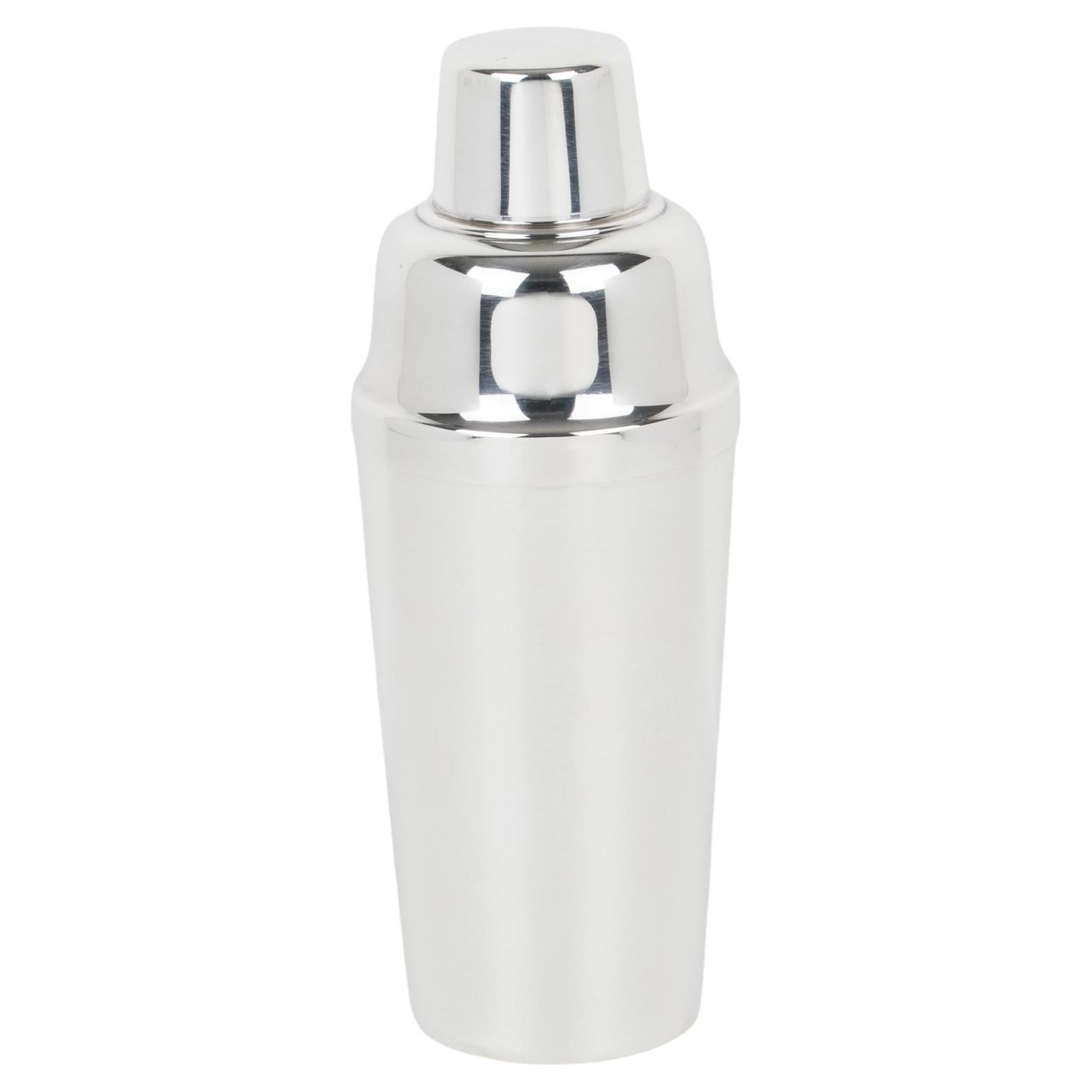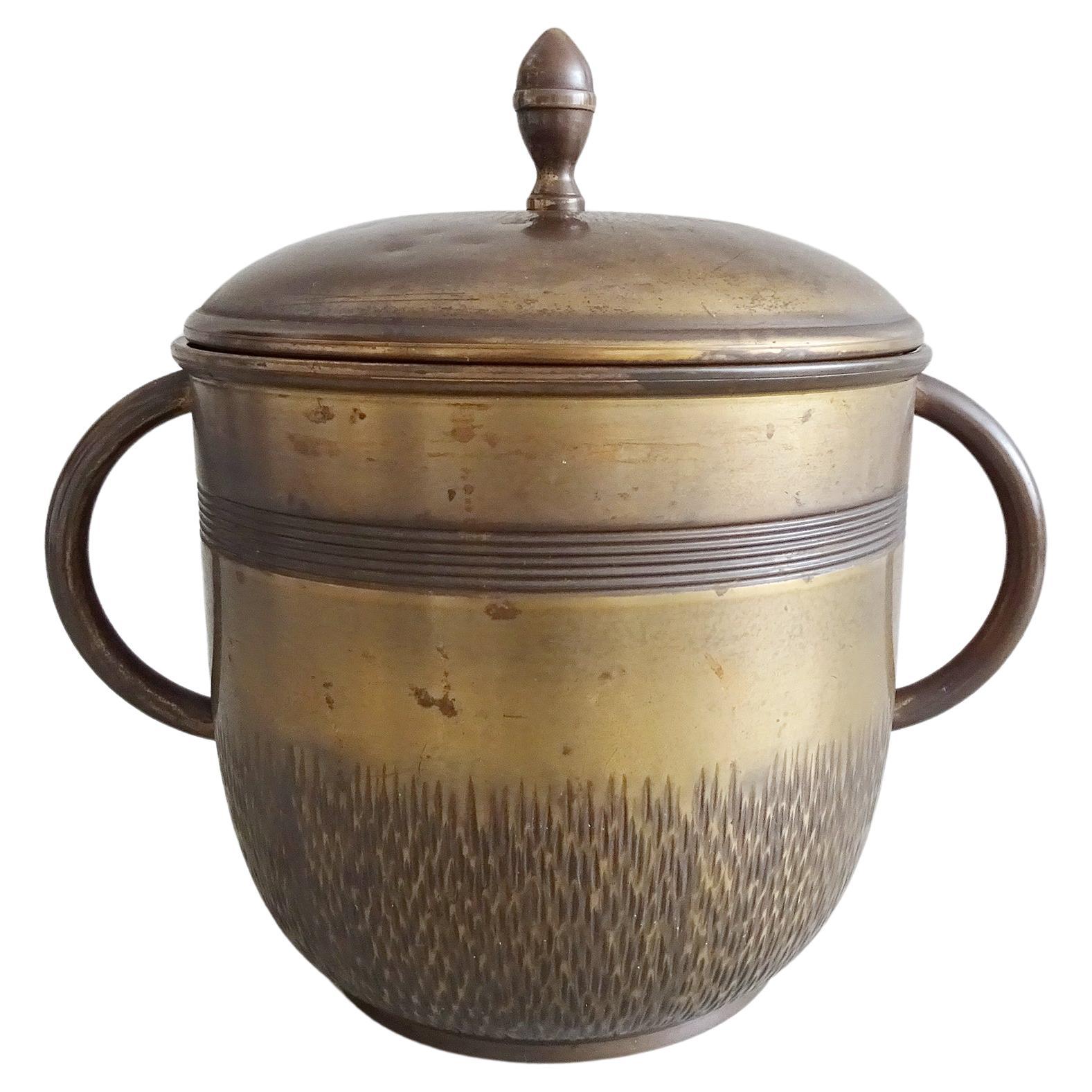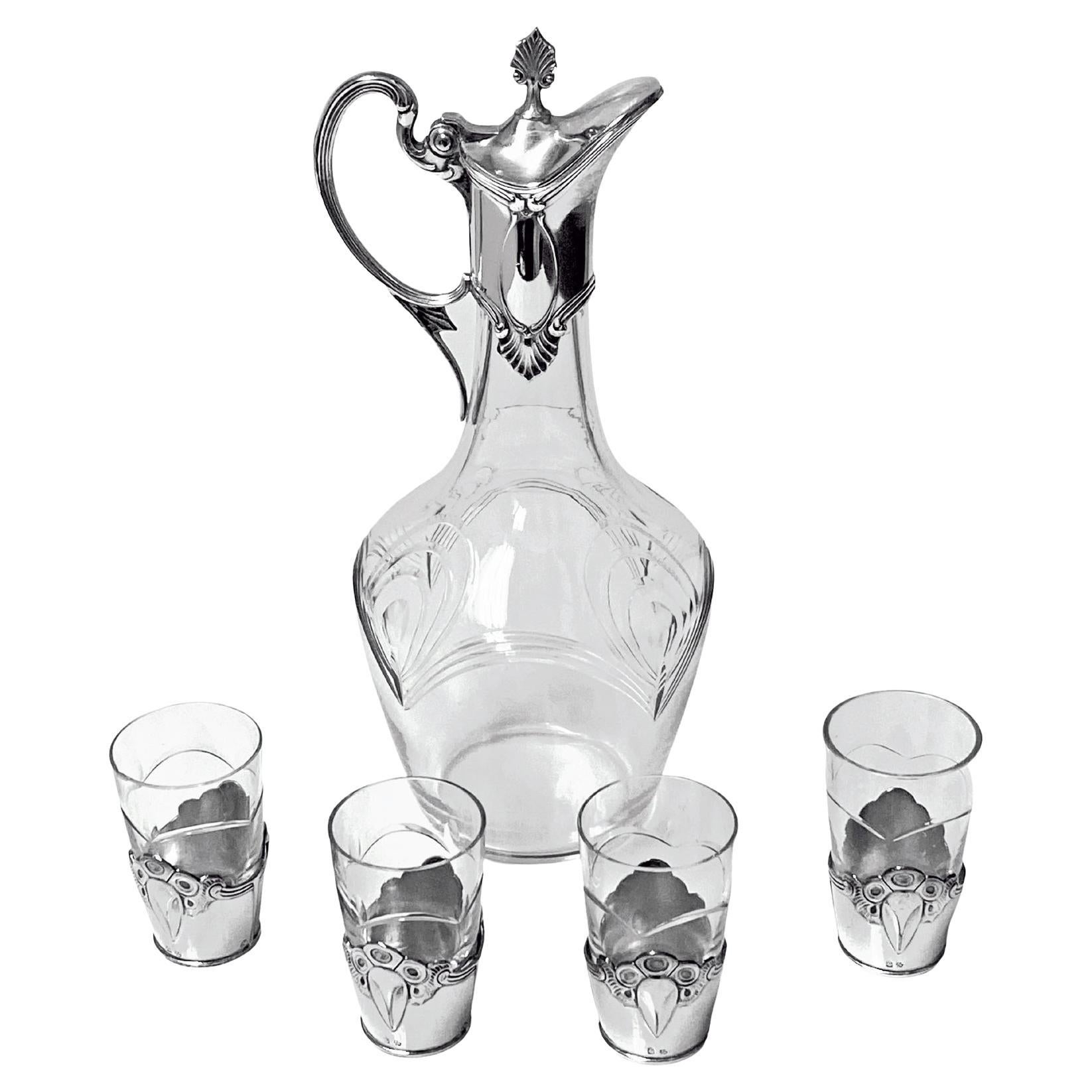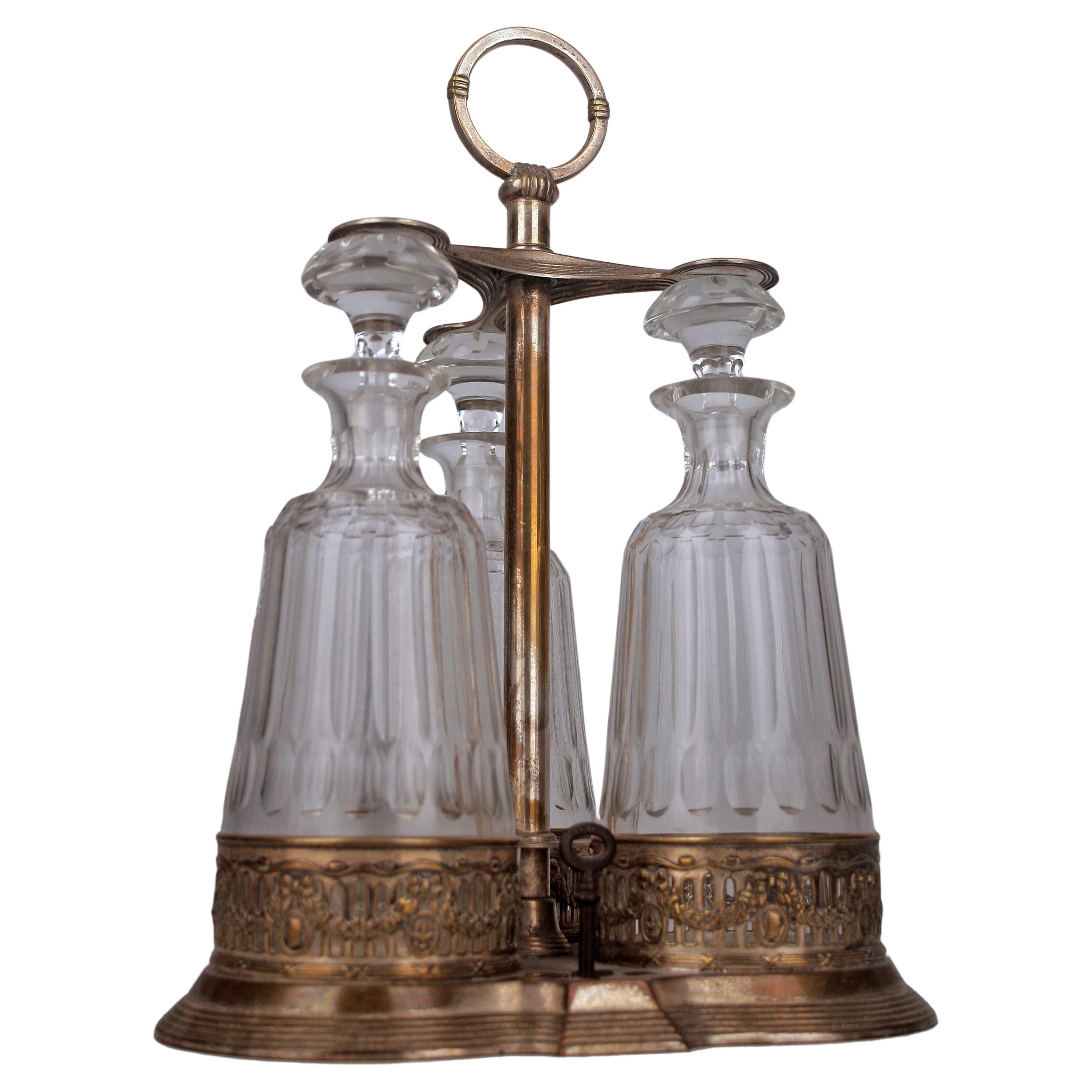Items Similar to Art Nouveau Silver Plate Swan Decanter WMF
Want more images or videos?
Request additional images or videos from the seller
1 of 21
Art Nouveau Silver Plate Swan Decanter WMF
About the Item
Glass Body with Silver Plated Mounts
From our Glassware collection, we are pleased to offer this Art Nouveau Silver Plate Swan Decanter by WMF. The Decanter of beautiful elongated shape with bulbous glass body and long stem tapered neck with silver plated mounts. The top of the decanter with the Swans face hinged at the mouth to pour claret. The base with a pair of small feathered wings mounted to a scrolling lifted base elevating the bottle from the surface. Stamped to the base of the jug a/s WMFB dating to the early 20th century during the Art Nouveau period circa 1895.
WMF(B) (Württembergische Metallwarenfabrik) is a German tableware manufacturer which was founded in 1853 by Daniel Straub in Geislingen an der Steige a town in Southern Germany. WMF was originally called Metallwarenfabrik Straub & Schweizer and was opened as a metal repairing workshop. Through mergers and acquisitions, by 1900 they were the world’s largest producer and exporter of household metalware, mainly in the Jugendstil (Art Nouveau) style, designed in the WMF Art Studio under Albert Mayer, sculptor and designer, who was director from 1884 to 1914. The B after the hallmark designates the base metal used for silvering and shows that this was made of Britannia Metal, a tin-containing alloy. This hallmark was used between 1886-1903.
A/S Antique silver finish
Silver Plate is a term used when a metal object is coated in a thin layer of silver. The base of the object will be made from a metal such as brass and then a thin layer of Silver is applied to the entire exterior giving it the visual desire of silver. Silver Plate objects contain different hallmarks to Solid Silver and often do not have any hallmarks at all.
Art Nouveau was an international style of art and architecture, especially the decorative arts. It was inspired by natural forms such as the curves of plants and flowers. Other characteristics of Art Nouveau were a sense of dynamism, movement and the use of modern materials particularly iron, glass and ceramics to create unusual forms. It was popular between 1890 and 1910 during the Belle Époque period and before the First World War. It was a reaction against the academic art, eclecticism and historicism of 19th century architecture and decoration.
Measurements (centimetres) 35.5cm High x 13.5cm Wide x 19cm Deep
- Creator:
- Dimensions:Height: 14 in (35.56 cm)Width: 5.3 in (13.47 cm)Depth: 7.5 in (19.05 cm)
- Style:Art Nouveau (Of the Period)
- Materials and Techniques:
- Place of Origin:
- Period:
- Date of Manufacture:1895
- Condition:Wear consistent with age and use.
- Seller Location:Newark, GB
- Reference Number:
About the Seller
5.0
Vetted Seller
These experienced sellers undergo a comprehensive evaluation by our team of in-house experts.
Established in 2019
1stDibs seller since 2022
18 sales on 1stDibs
Typical response time: 3 hours
- ShippingRetrieving quote...Ships From: Newark, United Kingdom
- Return PolicyA return for this item may be initiated within 14 days of delivery.
More From This SellerView All
- WMF Roller Skating Cigarette CaseBy WMF Württembergische MetallwarenfabrikLocated in Newark, EnglandRare Roller Skating Cigarette Case The Cigarette Case of slim rectangular form plated in Silver features a central front scene with three male figures r...Category
Early 20th Century German Art Nouveau Sheffield and Silverplate
MaterialsMetal, Silver Plate
- Art Nouveau Gradient Perfume BottleLocated in Newark, EnglandFitted with the original Glass Stopper The bottle of large sized with tapered base and top with a gradient Green hand cut glass body, silver hinged lid and original glass stopper. T...Category
Early 20th Century Central American Art Nouveau Glass
MaterialsSilver, Sterling Silver
- English Silver Engraved Decanter Widdowson & VealeBy Alexander MacRaeLocated in Newark, EnglandThe Decanter of slim tapered form with bulbous body, splayed circular foot with pinched stem and shaped opening. The Decanter extensively decorated throughout the body with two large fern leaves stemming from a central tied ribbon in the form of a bow. The decanter features a rounded handle fitted to the upper half of the decanter with a hinged shaped lid opening with gravity. To the base of the decanter an engraving reading “Jesse Collings. from I. Chamberlain.” Hallmarked to the neck AM (Alexander Macrae), Lion passant (sterling silver), Leopard Head town mark for London, Date letter R (1872) and the sovereign head duty mark. The Decanter is complete with its original latched fitted box lined in purple velvet with gold stringing to the exterior and the retailers mark to the inside doors “Widdowson & Veale, Goldsmith & Jewellery, to the Court of Spain, 73 Strand London.” Widdowson & Veale George Widdowson (b. 1804 Lincoln – Died 1872 Dulwich Village) was a celebrated silversmith and goldsmith although he took the route of retailer rather than a craftsman and by the age of 28 he had taken over his uncle’s London shop on the Strand, London. His uncle John Salter had been a close friend of Lord Nelson’s daughter, Horatia, and was godfather to one of her children. The shop was very successful and John Salter had supplied Nelson with many pieces of jewellery, including mourning rings. Widdowson developed the shop into Widdowson & Veale located at No. 73 Strand on the corner of Adam Street and opposite the Adelphi. Widdowson had a real eye for marketing. He once had a detailed newspaper article dedicated to his proposal to make a copy of Aeneas’ shield, as described in Virgil’s Aeneid. There is no evidence the shield was ever made though it did get good publicity. The company made swords and other weapons for the British army and navy, orders and decorations for the British court and were goldsmiths and jewellers to the court of Spain. In 1842 on the christening of Queen Victoria’s eldest son (later King Edward VII), Widdowson’s eye for publicity meant that the firm gave a christening gift of ‘an immense silver coronet supporting the Prince of Wales feathers.’ Widdowson & Veale were also makers to HRH the Duke of Sussex and the Court of Spain. In 1844, George was 40 and his business was doing well, as was the economy as a whole. The firm were able to advertise for apprentices, asking for a premium of £100. On 11 February 1847 George married Eliza Duffield (nee Boville), the daughter of a Putney wine merchant who had been living in Gibraltar but returned when her first husband, John Duffield, died. George and Eliza were middle-aged when they married and did not have children. Alexander Macrae founder of the firm that went on to be C J Vander Ltd. Macrae was recorded at 32 Bow Street, Covent Garden, London September 1856. He was joined in partnership by Martin Goldstein c. 1870, whereupon the style of the firm was changed to Macrae & Goldstein – first listed in 1871 as a silversmith. Alexander Macrae supplied many of the great firms at that time such as Elkington, Harry Emanuel...Category
Antique Late 19th Century British Late Victorian Pitchers
MaterialsSilver, Sterling Silver
- Silver Plate Lidded Tankard Elkington & Co. 'Attributed'By Elkington & Co.Located in Newark, EnglandFine Elkington & Co. (Attributed) silver plated lidded tankard. The tankard of typical shape with hinged lid, slightly tapered body with u-shaped handle. The tankard profusely decorated with repousse type silver plated relief...Category
Antique 19th Century British Rococo Sheffield and Silverplate
MaterialsMetal, Silver Plate
- German Silver Gilt Minaudière Louis KuppenheimBy Louis KuppenheimLocated in Newark, EnglandThe minaudière of rectangular form with curved corners features a repousse monkey which humorously goes through the case with the front side of the monkey on the cover and the rear side of the monkey on the back. The exterior of the case is gilded Silver with cabochon Sapphires and a top carry loop. To the left of the top a second loop contains the original pencil which pulls out for taking notes upon the ivorine notepad within. The interior of the case features several compartments which open via the Sapphire tabs, the left side contains two smaller compartments while the right side features a bevel edged mirror with an ivorine notepad to the reverse and a spring loaded tab to the compartment. The case is hallmarked in several locations with the London ‘omega’ import mark (1906-1998), the import Silversmiths mark Gresham Barber & Co and is dated 1907. Although the minaudière does not bear the original makers hallmark we firmly attribute the case to Louis Kuppenheim a renowned German Silversmith who made designs matching this minaudière. Louis Kuppenheim (1824-1889)was founded in 1854 together with Heinrich Witzemann they were located in Pforzheim, southwestern Germany and is known as the gateway to the Black Forest. In 1857 Kuppenheim moved forward as a solo business without his partner and moved to Durlacher Straße 1, Old Town street in Pforzheim. Upon the death of Louis Kuppenheim in 1889 3 of his 6 children (Albert, Hugo and Moritz) took over running the company and in 1900 at the Universal Exhibition in Paris the firm won a gold medal for a paper knife. In the same year the company opened the first store in the Rue de Richelieu 67 in Paris. In the 1900s Hans Christiansen designed some silver parts and pieces of jewellery, which were made by the Manufacture Kuppenheim. Christiansen was an important Art Nouveau painter and a member of the Darmstadt artists’ colony. In 1906 Albert, Hugo and Moritz convert the inherited jewellery factory into a modern gold and silverware fabrication and one year later relocated to 69 Durocher Street. Over the next 30 years the company expanded their business with mechanical workshops for gold and silver along with more machinery along with the death of Albert Kuppenheim and Ludwig (another son of Louis) taking over the company. After the war broke out in 1939 the company went into liquidation ending its 82 year history. During the heyday of the company over 200 people were employed by Louis Kuppenheim making it one of the most important employers in the jewellery city of Pforzheim. In the more than eighty years of production some 100,000 pieces left the company. Kuppenheim made many items in small series, for example boxes and minaudières (women’s fashion accessory, generally considered a jewellery piece, intended to substitute for an evening bag. A case with compartments, it allows storage for several items in a small space, such as a makeup compact, lipstick, watch, reading glasses, or keys) and compacts and cigarette cases...Category
Antique Early 1900s German Art Nouveau Sterling Silver
MaterialsGold Plate, Silver
- Austrian Silver & Enamel Horse Snuff BoxLocated in Newark, EnglandThe box of rectangular shape with faceted corners topped with an enamel scene featuring three horses grazing by the watering trough amongst a sunburst enamel background. The interior...Category
Antique Late 19th Century Austrian Art Nouveau Snuff Boxes and Tobacco B...
MaterialsGold Plate, Silver, Enamel
You May Also Like
- WMF, Germany Art Deco Silver Plate Cocktail ShakerBy WMF Württembergische MetallwarenfabrikLocated in Atlanta, GAThis fabulous Art Deco silver plate cylindrical cocktail or Martini shaker was crafted by silversmith WMF, Germany, in the 1920s. The three-sectioned cocktail shaker has a removable ...Category
Vintage 1920s German Art Deco Barware
MaterialsMetal, Silver Plate
- Art Nouveau WMF Brass Punch Bowl, Germany, 1900By WMF Württembergische MetallwarenfabrikLocated in Saarbruecken, DEAntique brass bowl with original glass insert, a decorative piece from the Art Nouveau period Elegant design made of solid brass with two large hand...Category
Antique Early 1900s German Art Nouveau Barware
MaterialsBrass
- Art Deco WMF Silver-Plated and Glass Cocktail ShakerBy WMF Württembergische MetallwarenfabrikLocated in Waddinxveen, ZHThis chic bar accessory is made by the renowned manufacturer WMF. The shaker is in a very good condition. The shaker has a removable cap and strainer. It is marked underside the cap ...Category
Vintage 1950s German Art Deco Sheffield and Silverplate
MaterialsSilver Plate
- WMF Art Nouveau Cut Glass and Silverplate Liqueur Set C.1900By WMF Württembergische MetallwarenfabrikLocated in Toronto, OntarioWMF Art Nouveau cut glass and silver plate Liqueur Set C.1900. The silver plate set with liqueur jug and four glasses in holders, each with stylized art nouveau design engraved cryst...Category
Antique Early 1900s Art Nouveau Barware
MaterialsSilver Plate
- Jugendstil Set of Silver Tantalus and Three Glass Decanters with Stoppers by WMFBy WMF Württembergische MetallwarenfabrikLocated in North Miami, FLJugendstil/Art Nouveau Set of Silver Tantalus and Three Glass Decanters with Stoppers by german company Württembergische Metallwarenfabrik (WMF) By: W...Category
Antique Late 19th Century German Jugendstil Barware
MaterialsCrystal, Metal, Silver Plate, Silver
- WMF Art Nouveau PlateBy WMF Württembergische MetallwarenfabrikLocated in Vienna, ATWMF Art Nouveau plate silver plated brass Germany about 1900-1910Category
Antique Early 1900s German Art Nouveau Platters and Serveware
MaterialsSilver Plate, Brass





